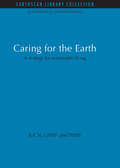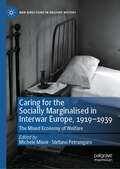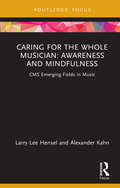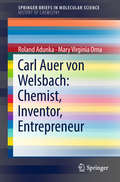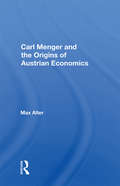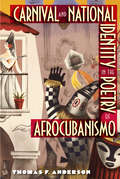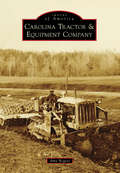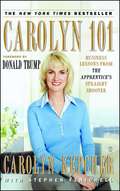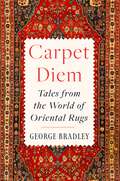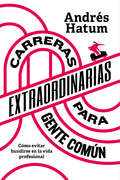- Table View
- List View
Caring for the Earth: A strategy for sustainable living (Sustainable Development Set)
by Wwf The World (Iucn) Unep'This is a strategy for a kind of development that provides real improvements in the quality of human life and at the same time conserves the vitality and diversity of the Earth. The goal is development that will be sustainable. Today it may seem visionary. but it is attainable. To more and more people it also appears our only rational option.' – from Chapter 1 in 1980, the International Union for Conservation of Nature and Natural Resources, the United Nations Environment Programme and the World Wide Fund for Nature, the world's three most powerful organizations dedicated to preventing environmental catastrophe, published the World Conservation Strategy. It stressed the interdependence of conservation and development, it gave currency to the idea of sustainable development and it made the point that unless the vitality and productivity of the planet are safeguarded, the future for humanity is at risk. Its impact was immediate and worldwide. Now, ten years later, the same three organizations have formulated a new strategy for the 19905. Caring for the Earth builds on all that has been learned in the last decade about the complexity of the problems and shows how radical and far-reaching are the actions and objectives needed to meet them. Nothing less than a new ethic is required, based on affirming the community of life and cherishing its diversity – an ethic which has to be reflected in our personal attitudes and the organization of our communities as much as in wider policies. Public participation is essential for the success of the strategy, which is addressed to individuals and citizens' groups as well as to governments - whatever their systems. Adopting it will not be easy, but it does provide the agenda for immediate action. Originally published in 1991
Caring for the Socially Marginalised in Interwar Europe, 1919–1939: The Mixed Economy of Welfare (New Directions in Welfare History)
by Michele Mioni Stefano PetrungaroThis book investigates the mixed economy of welfare that assisted socially marginalised people in interwar Europe, namely the state, local authorities, and a combination of voluntary and informal actors. While literature has traditionally emphasised the key role of the state, the cooperation between public authorities and private actors has always been a staple of social policy in Europe throughout history. The interwar years prominently featured these entanglements between the increased public sphere of action and the voluntary sector. Focusing on three thematic areas: warfare and its effects; boundaries of aid and institutional segregation; and gender and religion, the authors present case studies from various European countries between 1919 and 1939. All contributions explore the variegated world that composed the so-called mixed economy of welfare. By shifting the emphasis to the collaborations and frictions between social marginals, non-state actors, and public authorities on a local, national, and transnational level, the book challenges too simplistic distinctions between public and private initiatives and reveals the cultural, political, and practical common traits that featured in European care for marginals across a variety of geographical variations and socio-political contexts.
Caring for the Whole Musician: CMS Emerging Fields in Music (CMS Emerging Fields in Music)
by Larry Lee Hensel Alexander KahnCaring for the Whole Musician brings together insights from two expert musicians and educators to consider the relationship between mental and physical health and artistic practice for musicians. Offering a holistic perspective that encompasses the whole being – body, mind, and heart – this book provides emerging musicians with tools, practices, and mindsets to address key challenges throughout their journey. The first part, Awareness, addresses wellness and embodiment in music, exploring how our bodies are constructed and how the use of our bodies as instruments affects function. Using approaches including Body Mapping and the Alexander Technique, this part helps readers discover adverse habits that interfere with natural movement, and nurture awareness of the body. The second part, Mindfulness, explores how meditative practice can be incorporated into every stage of concert preparation and embedded within the daily life of the musician. Offering mindfulness exercises related to each stage of the music-making process, these chapters provide strategies for readers to enhance their well-being and focus. Centered in the understanding of the musician as a whole being, this book provides an essential guide to how practices of awareness and mindfulness can allow musicians to better care for themselves and flourish in their artistic careers.
Caring for the Whole Musician: CMS Emerging Fields in Music (CMS Emerging Fields in Music)
by Larry Lee Hensel Alexander KahnCaring for the Whole Musician brings together insights from two expert musicians and educators to consider the relationship between mental and physical health and artistic practice for musicians. Offering a holistic perspective that encompasses the whole being – body, mind, and heart – this book provides emerging musicians with tools, practices, and mindsets to address key challenges throughout their journey.The first part, Awareness, addresses wellness and embodiment in music, exploring how our bodies are constructed and how the use of our bodies as instruments affects function. Using approaches including Body Mapping and the Alexander Technique, this part helps readers discover adverse habits that interfere with natural movement, and nurture awareness of the body. The second part, Mindfulness, explores how meditative practice can be incorporated into every stage of concert preparation and embedded within the daily life of the musician. Offering mindfulness exercises related to each stage of the music-making process, these chapters provide strategies for readers to enhance their well-being and focus.Centered in the understanding of the musician as a whole being, this book provides an essential guide to how practices of awareness and mindfulness can allow musicians to better care for themselves and flourish in their artistic careers.
Carl Auer von Welsbach: Chemist, Inventor, Entrepreneur (Springerbriefs In Molecular Science)
by Mary Virginia Orna Roland AdunkaThis Brief documents the life, discoveries and inventions of the chemist Carl Auer von Welsbach. Particular attention is given to his pioneering work on the rare earth elements, including the discovery of four new elements, which allowed him to develop new materials, to invent new useful devices and to establish major industries. From the invention of the incandescent gas mantle and first electric incandescent lamps with metal filaments to the first mass production of radium from pitchblende residues, readers will learn the story of his notable legacy to the word through the lens of his rare earths knowledge.
Carl Icahn and Clorox
by Jay W. Lorsch Kathleen DuranteThis case outlines the takeover attempt by activist investor, Carl Icahn, for the Clorox Company. The board of the company repeatedly rejected Icahn's offers as inadequate. He made three bids over the course of three months.
Carl Menger And The Origins Of Austrian Economics
by Max AlterThis book deals with central elements of the cultural, political and social background of Austrian economic theory in general and Menger's version of it in particular. It draws on Menger's theoretical writings as well as on his explicitly methodological works as source material.
Carl Zeiss and Free-form Production: Can We See Clearly Yet?
by Willy ShihThe prescription eyeglass lens industry was complicated and highly fragmented, and even though many of the tools and techniques employed have been relatively unchanged over the last century, there was still a surprising pace of innovation. An aging population around the world meant the demand for progressive lenses was increasing rapidly, and innovations in production technology meant an evolving competitive dynamic with potentially quite different patterns of manufacturing and distribution. Are there theories that Zeiss managers can use to see clearly how industry evolution might portend shifts in the value network?
Carl Zeiss and Free-form Production: Can We See Clearly Yet?
by Willy ShihThe prescription eyeglass lens industry was complicated and highly fragmented, and even though many of the tools and techniques employed have been relatively unchanged over the last century, there was still a surprising pace of innovation. An aging population around the world meant the demand for progressive lenses was increasing rapidly, and innovations in production technology meant an evolving competitive dynamic with potentially quite different patterns of manufacturing and distribution. Are there theories that Zeiss managers can use to see clearly how industry evolution might portend shifts in the value network?
Carlton Polish Co.
by William A. SahlmanStudents are asked to determine the fair market value of Carlton Polish Co. and decide if Mr. Carlton should buy out his partner's half for $25 million. Carlton's alternative is to sell his half for $25 million. Students must also evaluate a financing plan.
Carme Ruscalleda: The Chef as an Artist
by Boris Groysberg Carin-Isabel Knoop Annelena LobbIn October 2018, Chef Carme Ruscalleda, the most-starred woman chef in the world at the time, closed the doors of her Restaurant Sant Pau (Sant Pau), as she had on almost every night for the past 30 years-this time for the last time. Ruscalleda had opened the restaurant in 1988 with her husband and partner. Sant Pau had a rating of three Michelin stars, the highest rating available to a restaurant through the well-known MICHELIN Guide to fine dining. Her other two restaurants-Sant Pau Tokyo, a sister restaurant in Japan, and Moments, in Barcelona's Mandarin Oriental Hotel-had two Michelin stars each. Many people-from the village and around the world-were sad to see the iconic restaurant close after so many decades. The case describes her approach to cooking, managing teams, dealing with stress, running a family business and constantly reinventing herself.
Carmichael Roberts: To Create a Private Equity Firm?
by Kenneth Cooper Steven RogersCarmichael Roberts, a rare African-American venture capitalist, considered leaving his general partnership in a private equity firm near Boston and setting up his own in 2015. He weighed whether the timing is right, with the economy still not fully recovered from the Great Recession of 2007-2009. Where to base such a firm was another factor in his decision-making. A member of the board of the National Venture Capital Association, Roberts knew the industry was gravitating to the San Francisco Bay area, to invest in the social media and software startups centered there. His specialty and passion was bringing to market new products made from advanced materials that help people solve problems in their daily lives. That investment focus on manufacturing would go against the private equity trend, another factor he considered. But he knew few, if any, general partners at major private equity firms were focused singularly on the kinds of businesses he wanted to invest in. Roberts also took into account the possible impact on his mutually respectful relations with his fellow partners. From a housing project in Brooklyn, New York, Roberts became a scientist who did advanced study at Duke and Harvard, capped off with an MBA from MIT. He had experience as a developer of technical products for Fortune 500 companies, an executive of cutting-edge startups, and a venture capitalist for eight years. This case study also reviews how private equity investment works, the private equity spectrum, the history of venture capital, stages of venture capital funds, and their location.
Carnival Corporation: Cruising Through COVID-19
by Stuart C. Gilson Sarah L. AbbottIn March 2020, in response to the global pandemic, the cruise industry ceased operations. Carnival was the largest cruise line operator in the world, and CEO Arnold Donald and his management team worked to position the company to survive. They slashed operating expenses and capital expenditures, raised more than $10 billion in new debt and equity financing, and negotiated with creditors. Planned ship deliveries were cancelled, and less efficient ships were retired or sold. Had the company done enough?
Carnival Cruise Lines
by Lynda M. Applegate Robert J. Kwortnik Gabriele PiccoliHighlights the potential value of customer data and the choices and challenges the firm faces when attempting to capture this value. Carnival collects a significant amount of individual-level behavioral and demographic customer data. Senior management must now decide how to leverage such a wealth of data to improve firm performance through customer targeting and acquisition, customer retention, and customer profitability strategies.
Carnival and National Identity in the Poetry of Afrocubanismo
by Thomas F. Anderson“Traces the ways that Cuban poets dealt with issues of national identity, reflected in their views of Afrocubanismo, often in response to historical changes in public and official opinions on the most visual manifestation of Afro-Cuban culture: carnival.”—Choice “Uncovers a wealth of literary texts, primarily poems, that chart the impact of las comparsas, Afro-Cuban festival dances, on mainstream Cuban life. . . . Investigates the ways in which the relationship between racial and ethnic divisions, and between castes and classes, created a literary movement full to the brim with emotional and sensational resonances.”—Wasafiri “Underscores the sociopolitical and historical contexts of these poems which have shaped the literary production and message of the Afrocubanismo movement. . . . A tour de force.”—Callaloo “Successfully plumbs the position of the Afro-Cuban performer and brings into sharp relief the way politicians historically sought to affect all elements of Cuban culture.”—New West Indian Guide Carnival and National Identity in the Poetry of Afrocubanismo offers thought-provoking new readings of poems by seminal Cuban poets, demonstrating how their writings affected the development of a recognizable Afro-Cuban identity. Thomas Anderson examines the long-running debate between the proponents of Afro-Cuban cultural manifestations and the predominantly white Cuban intelligentsia, who viewed these traditions as “backward” and counter to the interests of the young Republic. Including analyses of the work of Felipe Pichardo Moya, Alejo Carpentier, Nicolás Guillén, Emilio Ballagas, José Zacarías Tallet, Felix B. Caignet, Marcelino Arozarena, and Alfonso Camín, this rigorous, interdisciplinary volume offers a fresh look at the canon of Afrocubanismo and offers surprising insights into Cuban culture during the early years of the Republic.
Carol Brewer's Investments
by Richard S. Ruback Julia D. StevensFollowing her husband's death in 1994, Carol Brewer took over the management of her family's investments. This case describes the decisions Brewer made during this process, including her choice to seek active account management, her selection of an investment firm, and her determination of asset allocation within her portfolio. In 2003, Brewer is reassessing her previous investment choices and considering changes she might need to make in the future in light of her plans to retire in six years and live on the income from her investments.
Carolina Tractor & Equipment Company
by Amy RogersFounded on honesty, hard work, conservative management, and family commitment, Carolina Tractor & Equipment Company was established in 1926 by L.M. Weisiger. "Mr. Les," as he was known, became an engineer for the South Carolina State Highway Department after serving in the US Army during World War I. To meet the growing demand for new roads during the mid-1920s, he formed Weisiger Paving Company and later, in 1930, purchased the controlling interest of Carolina Tractor. Under his leadership, Carolina Tractor & Equipment Company experienced great success and growth. Weathering the Depression and expanding across the state of North Carolina, the company opened additional offices in Asheville, Charlotte, Hickory, and Greensboro. In 1965, Mr. Les turned the company over to his son, Ed I. Weisiger Sr. Mr. Les chaired the company board until his death in 1980; his wife, Katharine, then took over. True to its historical roots, Carolina Tractor & Equipment Company remains a local, family-owned company aligned with the interests of the customers it serves throughout North Carolina.
Carolinas HealthCare System: Consumer Analytics
by John A. Quelch Margaret RodriguezIn 2014, Dr. Michael Dulin, chief clinical officer for analytics and outcomes research and head of the Dickson Advanced Analytics (DA2) group at Carolinas HealthCare System (CHS), successfully unified all analytics talent and resources into one group over a three year period. Rapid increases in computing power and decreases in data storage costs had enabled DA2's data architects to build predictive models incorporating complex clinical, financial, demographic, and claims data that would have been impossible to create only a few years before. However, in 2014, both Apple and Google announced features in their new mobile operating systems that collected and displayed output from various health-wearables (like heart-rate monitors or step-counters), as well as electronic medical record (EMR) data. Their expertise in analytics, access to demographic and location data, as well as large consumer bases, led Dulin to consider which players consumers would trust to integrate their healthcare data in the future and what role DA2 could play.
Carolinas HealthCare System: Consumer Analytics
by John A. Quelch Margaret RodriguezIn 2014, Dr. Michael Dulin, chief clinical officer for analytics and outcomes research and head of the Dickson Advanced Analytics (DA2) group at Carolinas HealthCare System (CHS), successfully unified all analytics talent and resources into one group over a three year period. Rapid increases in computing power and decreases in data storage costs had enabled DA2's data architects to build predictive models incorporating complex clinical, financial, demographic, and claims data that would have been impossible to create only a few years before. However, in 2014, both Apple and Google announced features in their new mobile operating systems that collected and displayed output from various health-wearables (like heart-rate monitors or step-counters), as well as electronic medical record (EMR) data. Their expertise in analytics, access to demographic and location data, as well as large consumer bases, led Dulin to consider which players consumers would trust to integrate their healthcare data in the future and what role DA2 could play.
Caroline Regis at Excel Systems
by Michael J. Roberts Anthony J. MayoThe case describes the effects of a proposed change in Excel's manufacturing strategy as seen through the eyes of the company's VP of Manufacturing, Caroline Regis. Following a merger with Gemini, Excel's new CEO advocates a new manufacturing strategy: outsourcing. Regis is threatened by the diminution in the role of in-house manufacturing and by the VP for Supply Chain Management at Gemini. The case traces Regis's reactions to the proposal. She seems ready to accede to the organizational politics and support the new strategy, only to change her mind and anger her superiors, who thought she would support the plan. She tries to seize control of the situation and threatens to resign if she is not allowed to determine the appropriate strategy. The case facilitates analysis and discussion of career and personal development issues regularly faced by high-potential employees by showing that particular career and behavior strategies that are successful at one point can become dysfunctional as professionals advance through an organization.
Carolyn 101
by Carolyn Kepcher Stephen FenichellKnown to the millions of viewers of the hit reality television show The Apprentice, Carolyn Kepcher attracted enormous media attention for her cool demeanor and her no-holds-barred assessments of the show's candidates in the boardroom each week. In particular, she was not shy about speaking out about her disappointment with the professional conduct of the female candidates, whom she felt too often resorted to using their sex appeal to move ahead and gain the favor of Donald Trump. But if anyone knows what to do to impress Donald Trump, it's Carolyn, his longtime employee and trusted adviser. In Carolyn 101, she reveals the secrets of her own success and provides readers with guidance for their professional lives. By looking at the types of people most often encountered in the workplace, she illustrates her advice with examples from her career -- largely within The Trump Organization -- showing readers how to: ace an interview ask for a raise or promotion maintain a healthy balance between work and home life deal with a difficult boss spot and seize potential business opportunities dress for success be a strong team member or team leader Inspirational to both recent college graduates entering the workforce for the first time as well as seasoned employees looking to distinguish themselves, Carolyn 101 will show ambitious professionals what they need to do to get ahead and take their careers even further than they had imagined.
Carpet Diem: Tales from the World of Oriental Rugs
by George BradleyA colorful tour through the enthralling world of oriental carpets and its unusual characters that is also an honest and often humorous meditation about beautiful objects and our impulse to collect them.One day, the prizewinning poet George Bradley happened to take note of a carpet that had lain beneath his feet for decades. Carefully studying its weave and pattern, he was astonished by its complexity and allure. He became suddenly fascinated, and his newfound curiosity about oriental rugs sent him on a thrilling adventure, introducing him to a little-known realm in which beauty, artistry, business, and history collide.Carpet Diem chronicles Bradley’s exploration of the world of oriental carpets, one in which he falls in love with a variety of captivating rugs and learns about the cultural background of the people who made them. A journey from innocence to experience, this entertaining account includes his encounters with the dealers, collectors, scroungers, restorers, and connoisseurs who inhabit an exotic and sometimes shady milieu. As he brings together his own story with those of these characters, he also tells some of the history of what is one of the world’s great art forms. Like Scheherazade, Bradley spins tale after tale about the sorts of gorgeous textiles found on the floors of mansions across Europe and America, in the portraits of Titian and Vermeer, in the faraway caves of Central Asia, and in bespoke shops of Manhattan, the Hamptons, and Westport, Connecticut.A narrative that combines the mesmerizing storytelling found in The Arabian Nights with the pilgrimage into history that unfolds in The Silk Road and the dramatic compulsion to possess rare elegance that propels The Orchid Thief, Carpet Diem is an unusual and charming memoir that testifies to the intricate beauty woven into our world.Carpet Diem features eleven full-color photographs throughout.
Carrefour, S.A.
by William E. Fruhan M. Jean de MontonInvolves a very rapidly growing retail chain that is financing itself in an unusual (and at first glance) risky fashion.
Carreras extraordinarias para gente común: Cómo evitar hundirse en la vida profesional
by Andrés HatumEste libro encara la problemática del mercado laboral y el desarrollo de la carrera profesional para todas aquellas personas que, en etapas diferentes de sus trayectorias, requieran entender los pasos a dar o no dar. Los desafíos en las diferentes etapas no son iguales, así como las preguntas que cada uno se realiza. «En el debate sobre la innovación y el futuro cercano se suele hablar de 'exponencialidad' para el avance tecnológico, pero lo cierto es que hoy presenciamos dinámicas exponenciales tan o más interesantes en el campo social, cultural y de vínculos. Nuestra relación con el trabajo es un claro ejemplo de estos cambios cámbricos que están definiendo un mundo muy distinto al que conocimos. Con ejemplos prácticos, rigor académico y una prosa llana de divulgación en management, en Carreras extraordinarias para gente común Andrés Hatum nos lleva de viaje por este océano de olas cada vez más altas. Donde la elección y la gestión de una carrera laboral pueden definir la suerte de una vida desdichada o plena en bienestar emocional».Sebastián Campanario, periodista y economista, autor de Ideas en la ducha, Modo esponja y Revolución senior «Necesitamos desesperadamente una brújula que marque el camino hacia la reconversión profesional. Por abundancia o falta de trabajo, por conformidad que entumece o por la convicción de cambiar para hacer algo que dé sentido; el escenario actual laboral es tan desafiante como rico en posibilidades. Andrés hizo un libro con su experiencia diaria que es, justamente, extraordinaria: decenas de entrevistas de primera mano, lecturas, tendencias y una mirada sin edulcorante del mundo ejecutivo del que está impregnado; y derrama acá desmitificaciones, ideas y consejos concretos, atendiendo cada frente posible para que cualquiera de nosotros pueda mirar su presente laboral y se haga las preguntas correctas hacia un presente y futuro profesional anclado en decisiones discernidas. Eso sí, abróchense los cinturones, porque el camino es de ripio».Martina Rua, periodista y autora de La fábrica del tiempo «¡Imperdible! Con una visión realista, que comprende el futuro del trabajo, Andrés Hatum nos guía por el camino más relevante e incierto de nuestras vidas: nuestra carrera profesional».Guibert Englebienne, fundador y socio de Globant, Chairman Endeavor Argentina
